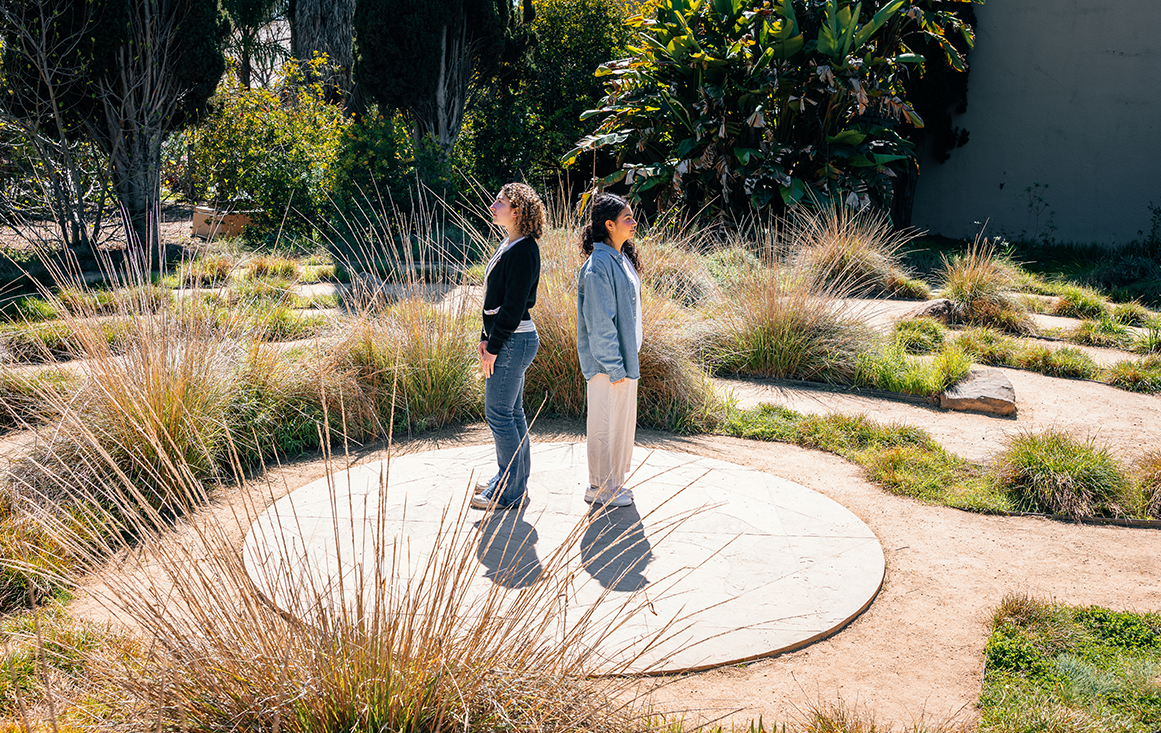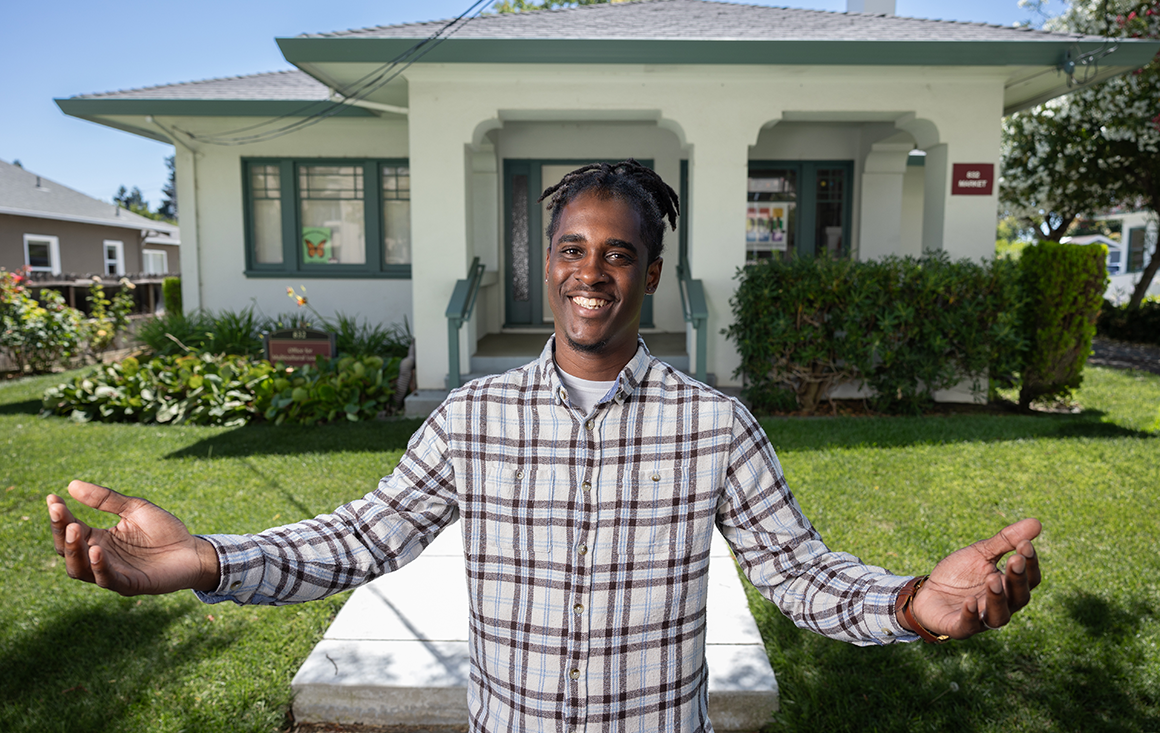Home Is Where the Dance Is
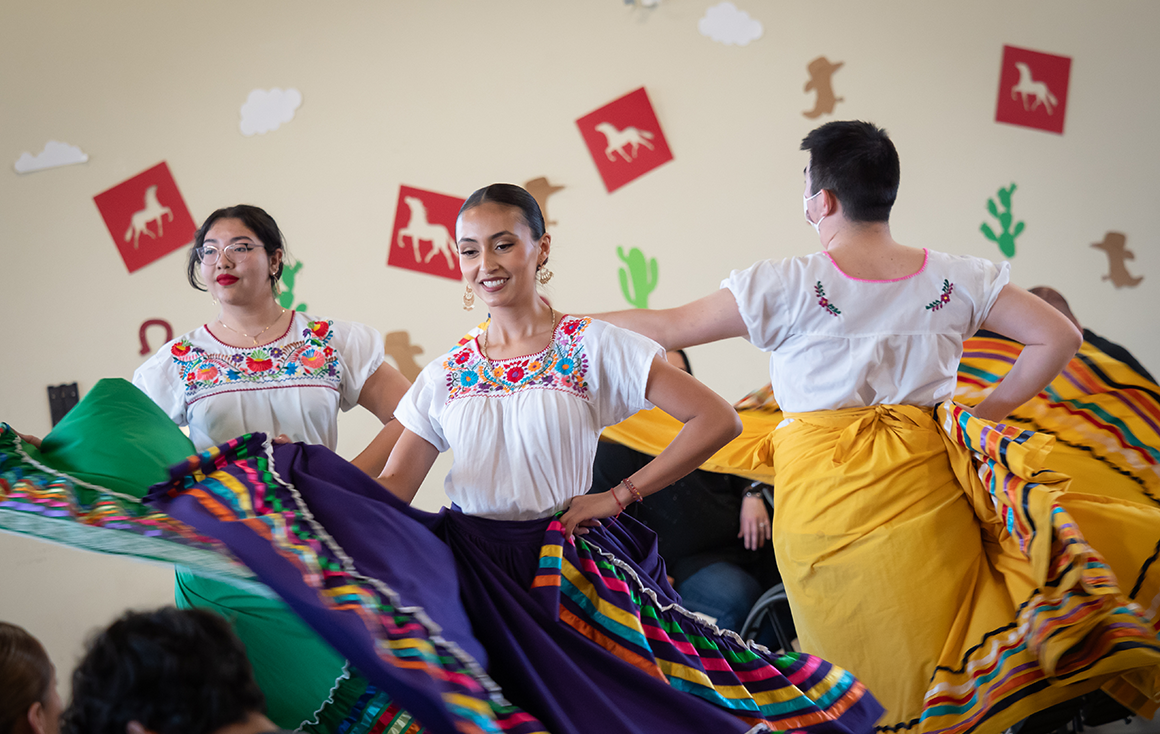
When most Americans think of Mexican folk dance, or baile folklórico, the most popular image might include stomping boots and swooping skirts in reds, pinks, and purples set to mariachi music.
But, did you know that this particular dance originates from the Mexican state of Jalisco and is just one of dozens of styles of baile folklórico, with each of the country’s 31 states boasting its own unique music, costumes, and steps?
As co-chairs of Ballet Folklórico de SCU, Maya Díaz ’25 and Isabella Estrada ’25 are on a mission to celebrate Mexico’s rich cultural heritage through the repertoire of dances they perform. To authentically represent these diverse dances, the group is currently fundraising to purchase a wider range of region-specific outfits—not just the colorful Jalisco skirts that audiences are familiar with.
From the vaquero-inspired denim jeans of Baja California to the delicate, white dresses of Veracruz, Ballet Folklórico plans to showcase the beauty of Mexico in the long-running club’s first-ever solo show at Santa Clara University. “Mi Primer Viaje a México” will take the stage at the Locatelli Student Activity Center on Sunday, May 5 at 5 p.m.
“We’re trying to spread awareness that there’s so much more to Mexico than what you usually see,” says Díaz. “Each region’s dance and costumes tell a unique story.”
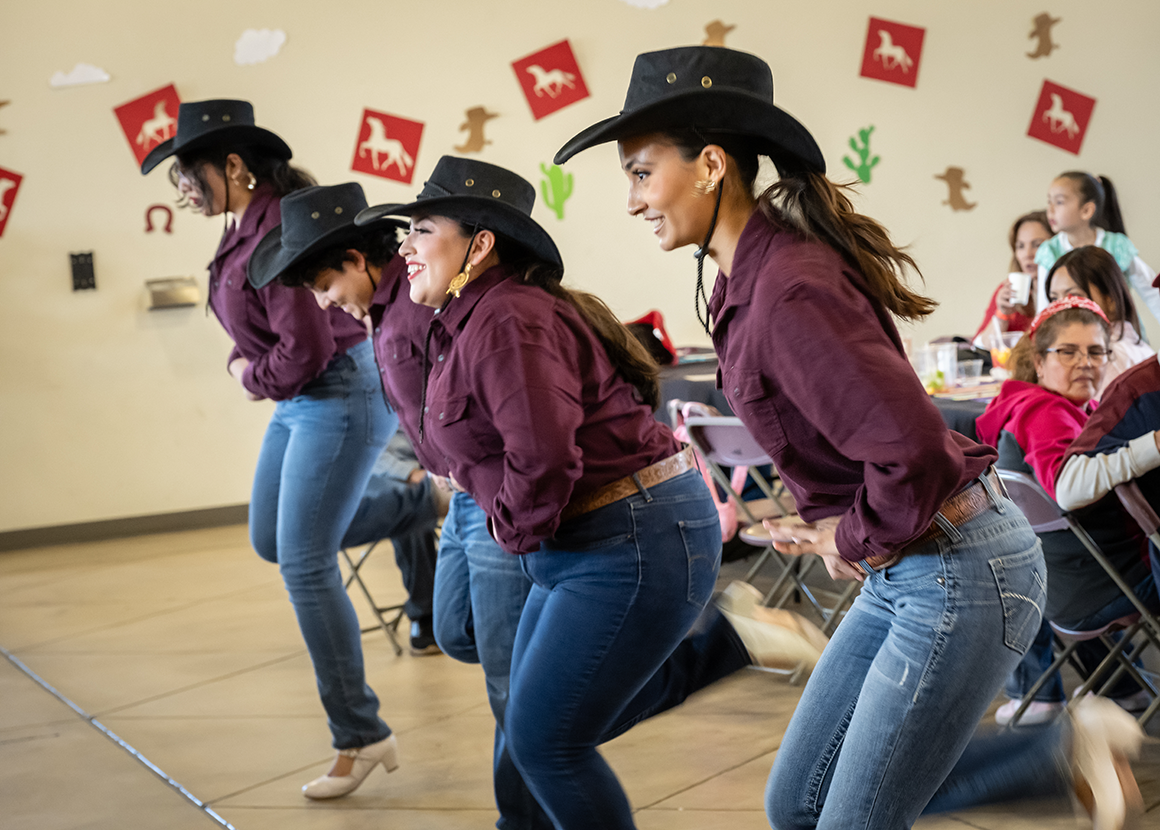
Ballet Folklórico performing Baja California-style dancing.
Dancing through the decades
Growing up in the predominantly-white city of Santa Clara in the 1960s and 70s was challenging, recalls Mayella Gardea ’92.
“In my formative years, my neighbors referred to my family as ‘dirty Mexicans.’” she says. ”At school, it was safer to eat a PB&J sandwich than a burrito, and people looked at you if you spoke Spanish. Fitting in was hard when you look different than the rest of your classmates.”
Because her parents both had to work, her childhood was fairly sheltered, without any after-school activities until she was 12. That’s when her father, Anastasio Gardea, a gardener at Santa Clara University, met Rick Mendoza ’77.
“He just had this really down-to-earth personality," Gardea remembers. “He was charismatic, charming, and could connect with and befriend people, both younger and older than himself.”
Over many shared lunches with Gardea’s father, Mendoza urged him to encourage his daughters to join a small group of friends he was teaching folklórico to.
At the time, the South Bay was a growing hub for Chicano culture, with Los Lupeños de San José being one of the largest and oldest folklórico groups in the U.S. As the Chicano rights movement grew, participating in Latino culture felt increasingly vital.
“A lot of people thought about folklórico as an adornment to the movement, but we were dancing at all the rallies and protests, from a strike at the Lucky’s on Alum Rock and King to rallies where Cesar Chávez spoke,” explains one of Rick’s students, Russell Rodríguez ’94, whose mother was one of the founders of Los Mestizos de San Jose, another long-running troupe. “Dance became this mediator and it brought people into the movement who might not have joined otherwise.”
Mendoza’s dance group was similarly political. While Mendoza was an original member of Los Lupeños, he had a different philosophy for sharing folk dances with future generations. While Los Lupeños emphasized the theatricality of folklórico, Mendoza believed in authenticity. To him, folklórico was more than the style of dance that could sell the most seats—it was an expressive movement of bodies within a larger political movement. Frequent trips across Mexico inspired him to start Grupo Folklórico Xochipilli, a group for young adults focused on precision footwork and learning a wide range of dances from master teachers across Mexico, including some indigenous dance styles.
His vision was likely inspired by his mother, renowned San Jose Chicana activist Sofia Mendoza. Among her many achievements, Mendoza led the first Latino student walkout in California, created the first health clinic in East San Jose, and formed the Community Action Patrol to monitor police activity. She was also a staunch folklórico supporter, using her connections to secure practice spaces for large dance groups and coming up with the name for Mendoza’s group.
In those early years, Xochipilli was mostly students from SCU and San José State University—and when young Gardea joined in, her entire worldview shifted.
“Despite the age difference, there was such a beautiful camaraderie. It was so refreshing to be able to speak Spanish and Spanglish around these students who were themselves in the midst of the Chicano movement. It was this awakening for me—it gave me the self-confidence to express my Chicano pride through my friends, the music I listened to, and my ’Cholismo’ fashion.”
Gardea brought that pride back to her high school, where she even organized the school’s first-ever Cinco de Mayo assembly featuring, of course, a folklórico performance. She continued dancing in Xochipilli, eventually becoming one of its dance directors by her 30s—right around the time she transferred to SCU.
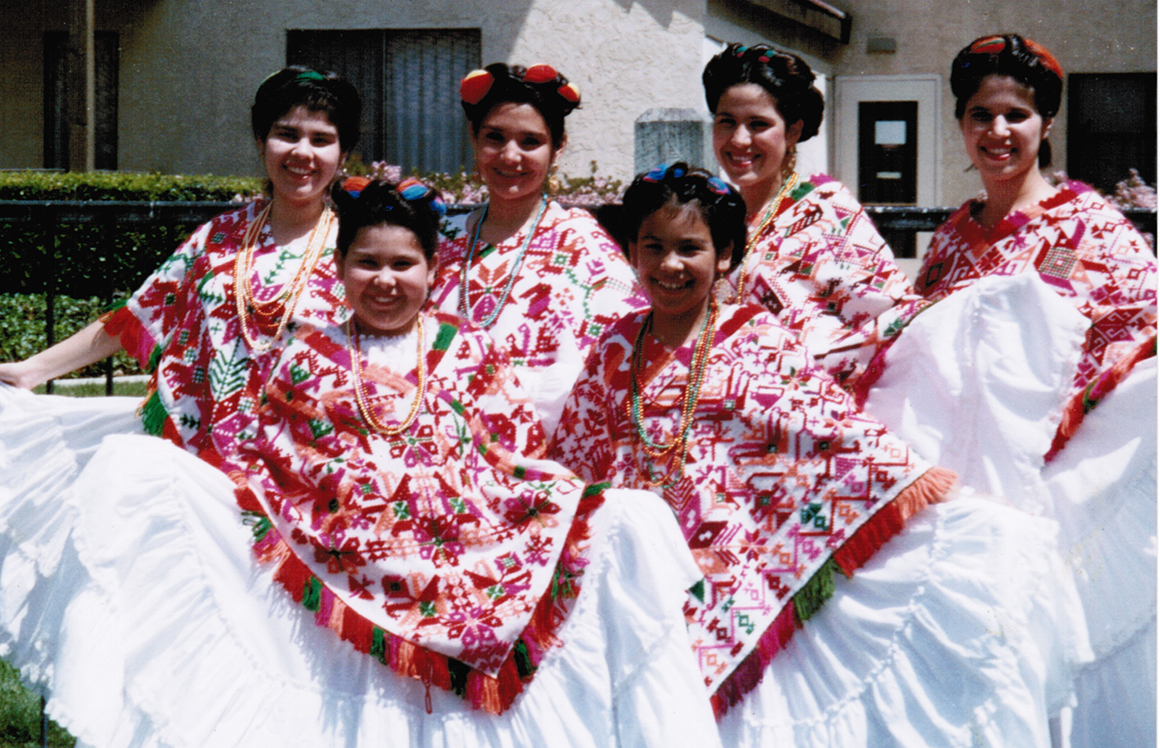
Anna Sampaio ’92 (far right) and fellow Ballet Folklórico and Xochipilli dancers in traditional dresses from San Luis Potosí.
Stepping home
When Anna Sampaio ’92 was in college, it was sometimes hard for her to feel like part of the Bronco family. At the time, students of color frequently faced discrimination and marginalization in an overwhelmingly-white institution. Eventually, a series of charged campus events inspired the Unity 2 movement.
Student activists, including Sampaio, organized around a list of academic and administrative demands, such as increased funding and a more central location for the school's neglected Multicultural Center (MCC), which was located in the Benson basement at the time.
“It was a pitched battle, I mean—blood and sweat,” recalls Sampaio. “We were so desperate to just exist in an alternative space that was deliberately marked as ‘not-white.’”
The toll of this daily struggle weighed heavily on Sampaio and other members of MEChA-El Frente, one of SCU’s Chicano student groups at the time. Despite not being Chicana herself—her family immigrated to the U.S. from Brazil and Argentina—Sampaio and other Latinx students came to MEChA looking for support and, most importantly, a sense of home in a place that didn’t always feel like one.
While baile folklórico groups at SCU existed before the 1990s, in the charged campus climate, Gardea felt she had something to offer her fellow MEChA members. In their role as directors of Xochipilli, Gardea and Rodríguez took on a teaching role for their classmates at SCU, passing on the same sense of pride and purpose that Mendoza had passed to them.
The SCU dancers practiced everywhere and anywhere they could—from the MCC to the Mayer Theatre to the back of the Mission Church. Though many dancers were of Mexican heritage, the group also had a large contingent of white, Filipino, and Black students, all eager to learn about the influence of colonialism and slavery on different musical traditions in Mexico.
While Sampaio acknowledges that the group’s very existence was transgressive at that moment in SCU’s history, she also describes the club as “life-giving” and a part of her decision to come back to Santa Clara in 2011, this time as a professor of ethnic studies.
“At the time, I didn’t have the language for why that club was so important, but it was precisely because we needed an expressive outlet that was joyful and rejuvenating—it was a safe place where we could play and have fun together.”
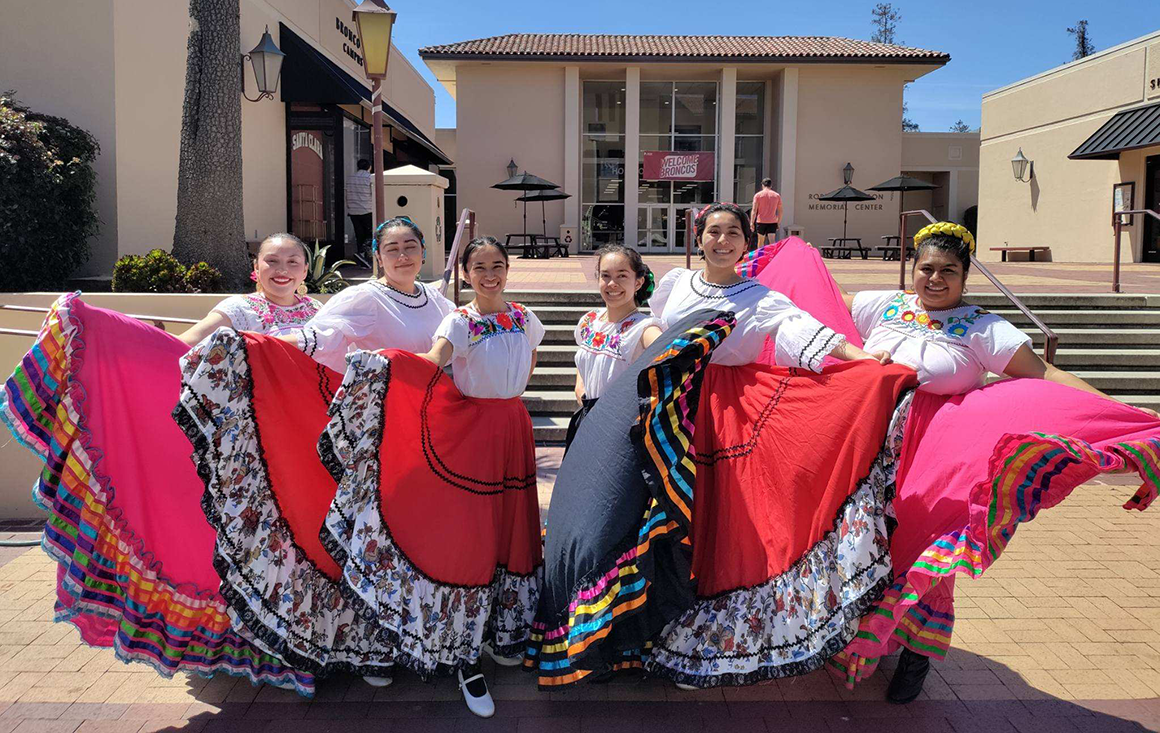
Ballet Folklórico members in both Jalisco and Sinaloa-style dresses.
Carrying the legacy forward
Though Latinx representation and inclusion at SCU has grown by leaps and bounds since the 1990s, Ballet Folklórico still plays an important role in offering fun, learning, and—as always—connection for SCU students.
When Crisol Padilla ’24 transferred to Santa Clara as a junior, it took just one look at the colorful skirts at the annual Student Involvement Fair to know she had found her place.
“The first practice that I went to, I was like, ‘I brought my high school dance shoes, I'm ready!’” she says. “Everyone saw how excited I was to be with them and we immediately bonded. It made my transition here a lot easier.”
Similarly, had she not joined Ballet Folklórico, Díaz says her Santa Clara experience would have been very different.
“As a commuter student, I always headed straight home after class. After a while, I realized that I didn’t know many people at Santa Clara—I had no connection at all, and I wanted to change that.”
Having danced for 17 years in Los Mestizos—coincidentally, the same group Rodriguez’s mother helped start—the idea of stepping into something familiar was the perfect nudge she needed. She now often leads group practice, guiding her friends through her favorite element of dance: complex footwork, or zapateado. The more challenging, the better, she says.
But of course, just as it was in Sampaio’s time, Ballet Folklórico still welcomes members with any cultural background or dance experience—whether you have classical ballet experience like Sean Tsang ’27 or you’re just looking for a way to get active like Mikaela Cerda ’26.
No matter where you come from or what you love most about the club, “dance brings people together,” adds Estrada, who hopes that Ballet Folklórico can continue carrying forward the legacy of the members who came before.
Though Mendoza passed away in 2012, his vision of authenticity and cultural pride lives on through his students, his students’ students, and the work Ballet Folklórico de SCU does today. It’s a legacy, Sampaio says, that will only survive through the support of the wider Santa Clara community. She’s donated to the club this year and hopes others will too, or snag tickets for its upcoming culture show.
“Ballet Folklórico is vital at Santa Clara—and even more so now, given that we are growing in terms of our Latinx community and its needs,” Sampaio says. “There are many ways to give, but this is certainly one of the more dynamic and engaging ways that people can support students.”
Ballet Folklórico de SCU is a cultural organization within Santa Clara University dedicated to creating an art-based sanctuary space that supports Latinx peers and changes our stereotyped narrative on campus.
